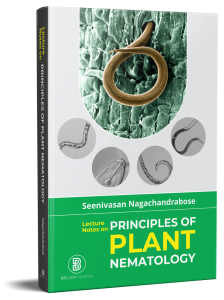About the Book:
Plant Nematology is the branch of Agricultural Science taught in State Agricultural Universities at under-graduate as well as post-graduate level. Plant parasitic nematodes are a worm like microscopic animals lives in soil and feeds parasitically on plant roots. Plant parasitic nematodes feed on plants by establishing a strong pathogenesis. Feeding by nematodes on roots causes malformation (gall like structure), lesions, rotting and necrosis that affect transport of water and nutrient. Though the plants affected by nematodes do not die instantly, its effect will affect economic yield. The loss by nematodes in agriculture is about
21.3% globally and annually we are losing 102040 million rupees (1.58 billion USD). Considering its importance, ICAR recommended to include ‘Plant Nematology’ as one of core course for M.Sc. (Plant Pathology) PG degree programme. In M.Sc. (Plant Nematology) already a core course is taught for students as ‘Principles of Nematology’. The curriculum syllabus for the both course is same. Until now, there is no guide or books are available for these PG courses. This book is designed to cover theory syllabus of ‘PAT 504 Plant Nematology’ and ‘NEM 501 Principles of Nematology’ courses.
Features:
The book is designed to have 20 chapters that covers lecture schedules of PAT 504 and
NEM 501 course syllabus.
Prepared in a simple language
The whole architecture of the book is in a bulleted form to make reading more interesting
The book has hand drawings for each important part of the notes to help the audience to
understand the notes quickly.
This textbook is not only useful for students, but also aid the teachers who taught NEM 501
and PAT 504 courses.
This book will fulfill the requirements of PG students and teachers of Nematology as well
as Plant Pathology disciplines
Characteristics of Phylum Nematoda and its Relationship with Other Related Phyla
History and Growth of Nematology
Nematode Habitats and Diversity
Useful Nematodes
Economic Importance of Nematodes to Agriculture, Horticulture and Forestry
Gross Morphology of Plant Parasitic Nematodes
Broad Classication of Nematodes
Nematode Biology
Physiology of Nematode
Ecology of Nematodes
Types of Phytonematode Parasitism
Nature of Damage and General Symptomology
Interaction of Plant-parasitic Nematodes with other Organism
Association of Nematodes with Insects and Other Organisms
Cellular Responses to Infection by Important Phytonematodes
Physiological Specialization among Phytonematodes
Principles and Practices of Nematode Management
Integrated Nematode Management
Emerging Nematode Problems
Importance of Nematodes in International Trade and Quarantine
References


